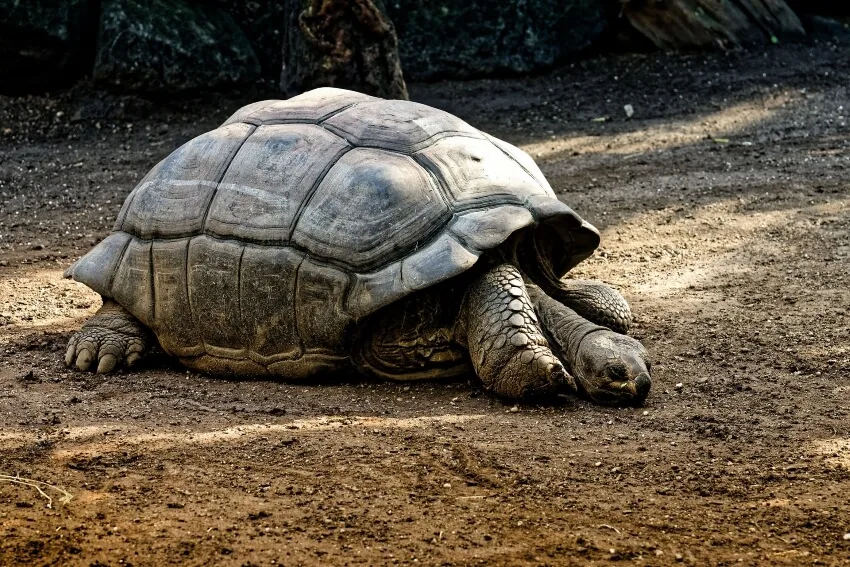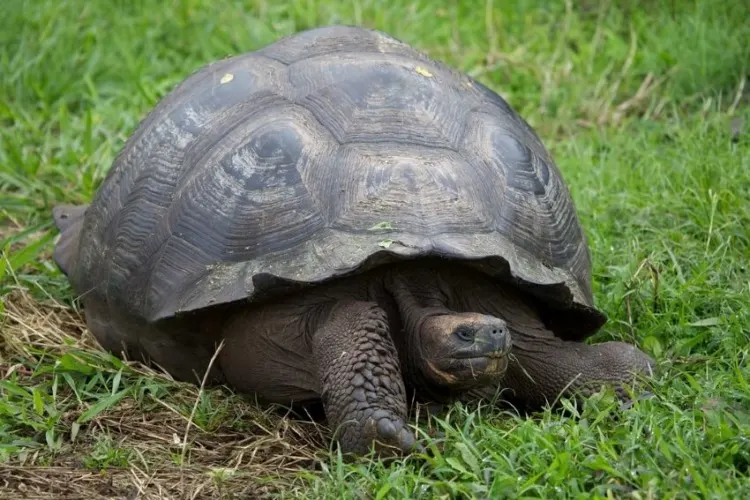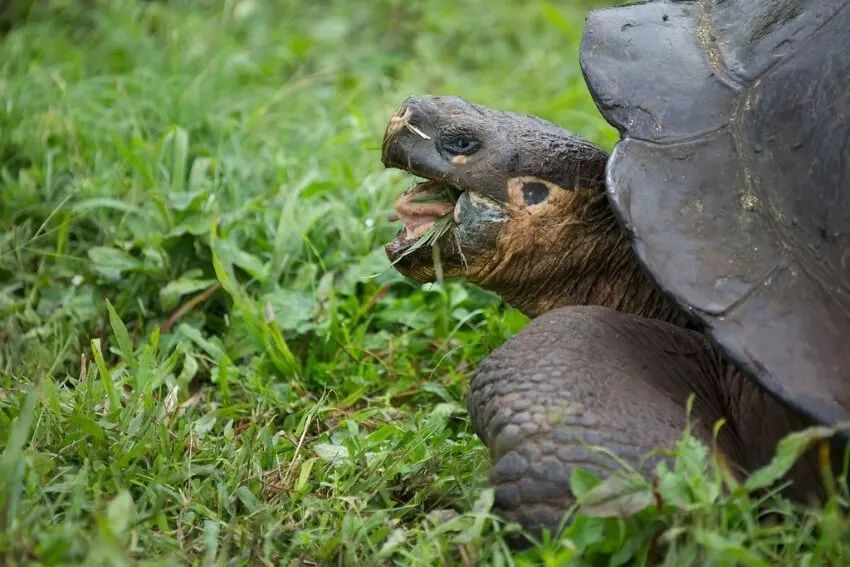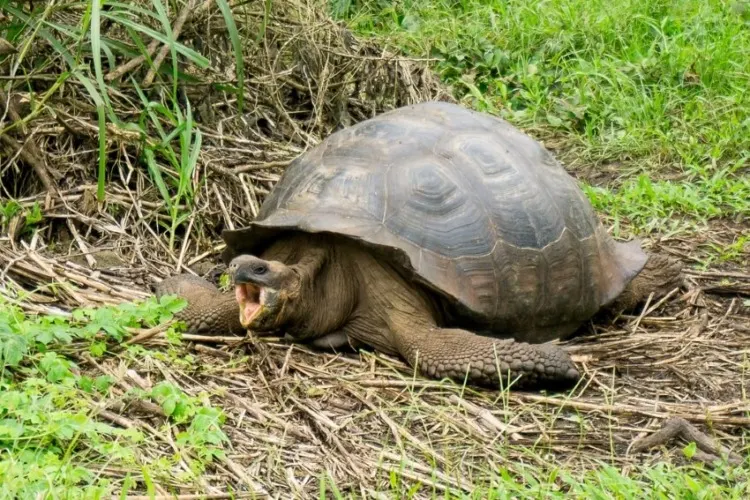The Galapagos Giant Tortoise is native to the arid islands of the same name, Ecuador. The tortoises are unique because they have adapted to a dry climate and food sources that change seasonally. They can grow up to 600 pounds and live more than 150 years.
- Status: Vulnerable
- Known as: Galapagos Giant Tortoise, Galapagos tortoise.
- Estimated numbers left in the wild: 19,000, possibly more (giant tortoise populations are increasing).
The species is thought to have originated in South America and arrived on the Galapagos Islands via rafting.
Description

Anatomy and Appearance
The Galapagos giant tortoise is a huge, slow-moving, brown-shelled tortoise and type of turtle that measures an average of 1.2 meters long and weighs 250 kilograms – though an occasional huge specimen can reach as much as 400 kilograms in weight.
Long-necked and small-headed, these tortoises move slowly enough so that lichen grows on the shells of some individuals as it might on a small boulder.
The tortoises likely were able to cross the ocean to these remote islands because of their size and bulk and the survival advantages that they gave them while floating over the waves, rather than becoming huge once they had colonized the islands.
The largest subspecies are found on larger moister islands, while the dry, small islands have smaller tortoise subspecies.
Male and female giant tortoises have some key physical differences. For one, the males tend to be larger than the females. Their shells are also shaped differently – the males’ shells are more oval-shaped, while the females’ shells are more round. Finally, the male’s tail is significantly longer than the female’s.
These physical differences extend to their behavior as well. Males are much more aggressive than females and will often fight over territory or mates.
On the other hand, female tortoises are much more passive and tolerant of others. This difference in behavior is likely due to the different reproductive roles that males and females play.
Male giant tortoises must compete for mates, while females must be careful not to exhaust themselves by fighting.
The Galapagos giant tortoise is a gentle, mild-mannered beast that lives a calm, tranquil life. A typical tortoise is active for 7 to 9 hours per day, spending the rest of the time sleeping or napping.
These tortoises also enjoy basking in the sun, and warming up their heavy bodies before foraging.
Galapagos Giant Tortoise Habitat
The Galapagos tortoise is endemic to the Galapagos Islands, located in the Pacific Ocean about 1,000 km west of Ecuador.
The islands comprise 13 major islands and six small satellite islands (These islands include Isabela Island, Pinzon Island, Espanola Island, San Cristobal Island, Santa Cruz Island, and Santiago Islands), with a total land area of 8,000 km2. The largest island, Isabela, accounts for more than half of the total land area.
The islands are volcanic in origin and were formed by the action of the hot spot beneath the Earth’s crust.
The subspecies from other arid islands are believed to be extinct.
Galapagos Giant Tortoise Diet and Nutrition
Grass, flowers, cactus flesh, and cactus fruits form part of the animals’ diet. Several tortoises often forage together in a loose group.
Giant tortoises store enough water and nutrients in their bodies to survive for up to a year without eating or drinking – another adaptation that helped their ancestors reach the islands long ago.
However, when food is available, they may eat as much as 36 kilograms daily.
Galapagos Giant Tortoise Mating Habits
Though generally quiet and docile, the adult tortoises become somewhat competitive in the breeding season. Males strive against each other not in combat but by attempting to stand taller and look larger.
The female lays up to sixteen tortoise eggs in a nest hidden in sandy ground, abandoning them after laying them. Those tortoises who survive the challenges of their early years can look forward to a lifespan of up to a century and a half, perhaps more in rare cases.
The eggs of the Galapagos Giant Tortoise are huge! They can weigh up to 2 pounds and measure up to 5 inches long.
The shells are very tough, so they can survive for a long time without food or water. Even if they are damaged, the tortoises can still hatch and survive.
The Galapagos Tortoise eggs are huge compared to the size of the hatchlings. It is not unusual for a single egg to weigh 1/4th of the adult tortoise! Surprisingly, the eggs are very fragile despite their large size and can be damaged easily.
The hatchlings are also quite small, only measuring about 4-5 inches in length. They are born with a softshell, which hardens as they grow older. The young tortoises are also very vulnerable to predators, and many do not survive their first year of life.
As they reach adulthood, the Galapagos Tortoises can grow to be quite large, with some individuals reaching lengths of over 6 feet! They can also weigh over 400 pounds.
Role in the Ecosystems
The Galapagos Tortoise is one of the most important animals in the Galapagos ecosystem. They are a keystone species because they play a critical role in the ecosystem’s health. Their grazing helps keep the vegetation healthy and prevents the growth of invasive plants.
The Galapagos Tortoise is also an important food source for many animals in the ecosystem, including the Galapagos Hawk and the Galapagos Penguin. Without the tortoise, these animals would not have enough to eat and likely starve.
If the Galapagos tortoise becomes extinct, the ecosystem of the Galapagos Islands will be disrupted.
The tortoise’s disappearance will have a domino effect on the plants and animals that rely on them for food and shelter. Without the tortoise, the islands will lose an important part of their history and culture.
See Related: Habita vs Ecosystem vs Biome
Subspecies

Abingdon Island Tortoise
The Abingdon(Pinta) Island Tortoise is a species of tortoise endemic to the Abingdon Island in Seychelles. It is a small tortoise that typically grows to 5-8 inches.
Lonesome George was the last of his species taken under the wing of Charles Darwin Research Station. He was a Pinta Island tortoise, and he was found dead on June 24, 2012. He was approximately 100 years old. Lonesome George’s death marked the end of an era for his species.
Lonesome George was a symbol of hope for his species. Conservationists had been working for many years to find a mate for him in the hopes of preserving his lineage. However, despite their efforts, no other tortoises were found that were compatible with Lonesome George.
Volcán Wolf Tortoise
The Volcán Wolf Tortoise (Chelonoidis nigra) is a vurnerable tortoise species endemic to Volcán Wolf, on Isabela Island in the Galápagos. This species is in decline due to the introduction of non-native predators, habitat destruction, and collection for the pet trade. There are estimated to be only 250–350 individuals remaining in the wild.
Chatham Island Tortoise
The Chatham Island Tortoise is a critically endangered species endemic to the Chatham Islands, located in the Pacific Ocean.
These tortoises are the largest living terrestrial reptiles in New Zealand, growing to weigh up to 50 kg (110 lbs). They have a dark green or black shell with a high, domed shape and a deep keel on the underside. The Chatham Island Tortoise is a herbivore, feeding mainly on leaves, fruits, and flowers.
The Chatham Island Tortoise is threatened by habitat loss and predation by introduced predators such as rats, cats, and dogs.
There are estimated to be only 500-1,000 individuals remaining in the wild, making it one of the most endangered reptiles in the world.
The Chatham Island Tortoise is protected under New Zealand law and focuses on conservation efforts by several organizations.
Santiago Island Giant Tortoise
The Santiago Island giant tortoise (Chelonoidis chilensis) is a species of Galapagos tortoise endemic to Santa Cruz Island in the Galápagos archipelago. It is the largest living land tortoise and is the third heaviest after two extinct species, the Floreana giant tortoise and the Pinta giant tortoise.
The Santiago Island giant tortoise is one of the most threatened taxa of the giant tortoises, with an estimated population of only 2,000–3,000 adult individuals. The major threats to its survival include introduced predators (e.g., feral cats), habitat loss, and illegal poaching for the pet trade.
Duncan Island Tortoise
The Duncan Island Tortoise is a vulnerable species native to the Duncan Island in the Galapagos Archipelago.
These tortoises are the largest in the world and can weigh up to 500 pounds. They have a brown or black shell and a reddish-brown head and neck. The Duncan Island Tortoise is a herbivore and feeds on grasses, leaves, flowers, and fruits.
The population of Duncan Island Tortoises has declined significantly in recent years due to habitat loss and hunting. There are currently only about 350 individuals remaining in the wild, making them one of the most endangered tortoises in the world.
Sierra Negra Giant Tortoise
The Sierra Negra Giant Tortoise is a critically endangered species found in the Galapagos. These tortoises can weigh up to 400 pounds and live up to 150 years old.
They are herbivores and eat a variety of plants, including cacti. Unfortunately, the Sierra Negra Giant Tortoise is threatened by habitat loss, hunting, and predation by introduced species.
Hood Island Tortoise
The Hood Island Tortoise is one of Earth’s most critically endangered species.
The tortoise has been pushed to the brink of extinction by hunting and predation by feral animals and the introduction of non-native plants. There are estimated to be fewer than 100 individuals remaining in the wild.
The Hood Island Tortoise is found only on Hood Island, part of the Galapagos. The Galapagos are a UNESCO World Heritage Site known for their unique biodiversity. The Hood Island Tortoise is one of several endemic species found on the islands.
Volcán Darwin Tortoise
The Volcán Darwin Tortoise is a critically endangered species endemic to the Galapagos. These tortoises are so named because they are found on the islands of Darwin and Wolf.
They are medium to large, with a shell length of up to 25 cm. They are mostly black or dark brown, with a yellowish or greenish underside.
The Volcán Darwin Tortoise is threatened by habitat loss and introduced predators.
In addition, tortoise eggs and hatchling tortoises are preyed upon by both feral animals and other tortoises. As a result, the population of Volcán Darwin Tortoises has declined by more than 95% in the past century.
Floreana Island Giant Tortoise
The Floreana Island Giant Tortoise is an extinct species endemic to the Floreana Island in the Galapagos. These tortoises can weigh up to 400 pounds and live for more than 100 years.
Fernandina Island Tortoise
The Fernandina Island Tortoise is one of the most endangered species of turtles in the world. There are only about 1000-2000 individuals left in the wild, and they are threatened by habitat loss, hunting, and predation by introduced predators.
These tortoises live on a small, isolated island off the coast of Ecuador, and their population has declined drastically in recent years due to a combination of factors.
The Fernandina Island Tortoise is a beautiful animal with a brownish-gray shell and a long neck. They are herbivores and eat various plants, including cactus, grass, and leaves. They are also known to drink water from rain puddles or streams.
Western Santa Cruz Island Tortoise
The Western Santa Cruz Island Tortoise (Gopherus agassizii) is a critically endangered species of tortoise that is endemic to the Channel Islands of California.
The species is currently restricted to one location on Western Santa Cruz Island. Only about 250 individuals are estimated to remain on the island, making it one of the most endangered tortoises in the world. The primary threats to the species are predation by non-native animals and habitat loss.
Santa Fe Island Tortoise
The Santa Fe Island Tortoise (Chelonoidis abingdonii) was a species of tortoise endemic to the Santa Fe Island in the Galapagos. The tortoise became extinct due to a combination of feral cats and dogs and habitat destruction.
Volcán Alcedo Tortoise
The Volcán Alcedo Tortoise is a vulnerable tortoise species found in the Galapagos. The Volcán Alcedo Tortoise is a herbivorous reptile that feeds primarily on grasses, leaves, and flowers.
Iguana Cove Tortoise
The Iguana Cove Tortoise is an endangered species that is found only in the Iguana Cove area of the Galapagos. These tortoises are known for their colorful shells and are one of the unique animals in the Galapagos. They are also quite small, typically weighing only around 25 pounds.
The primary threat to the Iguana Cove Tortoise is habitat loss. The cove where they live is being developed more and more each year, and the tortoises are struggling to survive in the changing environment. In addition, they are susceptible to predators like dogs and cats, and they kill many.
Galapagos Giant Tortoise Facts
Here are the fun facts you need to know about these giant tortoises
- The Galapagos tortoises are the world’s largest living tortoises and can weigh up to 550 pounds.
- They are found in the Galapagos and are a popular tourist attraction.
- The giant tortoises are known for their long life span, with some individuals living over 150 years.
- Argentina and Paraguay’s Chaco tortoise is the giant tortoise’s closest living relative.
- These animals are herbivores and primarily eat vegetation such as leaves and grasses.
- The tortoise enjoys a mildly symbiotic relationship with Galapagos finches on some islands, where these birds clean parasites off the tortoises’ skin and get a tasty snack in exchange.
- The oldest known Galápagos tortoise, Harriet, reached over 170 years old and is located in Australia.
See Related: Books Endangered Species
Conservation Status

The Galapagos giant tortoise is listed as “Vulnerable” on the IUCN Red List, with a decreasing population trend.
Threats
Hunting
Hunting has a significant impact on the tortoise population. When hunters are out in the field seeking their prey, they often target giant tortoises as well. This can lead to a decrease in the population as adult tortoises are killed.
The Galapagos giant tortoise was hunted mercilessly for meat in the past by the crews of passing ships, especially pirates in the 17th century and whaling ships in the 19th.
Probably around 200,000 Galapagos tortoises were killed and eaten at this time. By the 1970s, only 3,000 giant tortoises remained, though reintroduction has helped to bolster their numbers greatly.
Poaching still occurs at a far lower level than in the past when there were no protections for the tortoises.
Low Birthrate
The Galapagos tortoise is an endangered species affected by low birth rates. The main reason for the low birth rates is that there is a lack of males in the population. The males are affected by poaching, which is the illegal hunting of animals.
The females are also affected by the lack of males, as they cannot reproduce. But captive breeding and breeding center works to raise the tortoise populations.
Predators and Invasive Species
Today’s main threat comes from domestic animals introduced to the islands and now existing as feral populations or introduced vermin. Rats, cats, dogs, and pigs all prey on young tortoises, though the adults are too large and too well armored to fall victim to them.
Feral goats devour the food that the tortoises need to survive.
Galapagos giant tortoise populations suffered a tremendous decline due to predation by whalers, buccaneers, and fur sealers.
Invasive species can have a devastating effect on tortoise populations. They can outcompete the tortoises for food and carry diseases that can kill the tortoises. As a result, the tortoise population can decline rapidly, and in some cases, it can even disappear from an area entirely.
Conservation Efforts

Galapagos giant tortoises enjoy full legal protection and cannot be legally hunted, captured, or transported off the islands.
A highly successful program at the Charles Darwin Research Centre and Galapagos National Park involves raising young tortoises until they are five years old and better able to survive.
And after the successful program of raising the tortoises, next is releasing them – a program that has single-handedly brought the species back from the brink.
Feral animals of all kinds have been culled – and in some cases, eradicated – on many of the islands, an ongoing task that helps to create better conditions for tortoise survival.
Here are the some of the simple ways to conserve Galapagos tortoises:
- Don’t touch or disturb tortoises when you see them in the wild.
- Don’t pick up tortoises; they may feel threatened and can scratch or bite.
- Keep dogs on leashes when walking in Galapagos tortoise habitats.
- Refrain from feeding tortoises; it can make them ill.
- Do not buy products made from tortoise shells or eggs.
- Don’t step on vegetation; this can damage the delicate roots and leaves that Galapagos tortoises need to survive.
- Leave shells and other artifacts where you find them.
- Be sure to dispose of trash properly.
- Do not introduce new plants or animals to the Galapagos Islands.
See Related: Conservation vs Preservation
Galapagos Tortoise Movement Ecology Program by St. Louis Zoo
The Galapagos Tortoise Movement Ecology Program by St. Louis Zoo is a research program that studies the movements of the Galapagos tortoise.
The program has been able to collect data on the tortoises’ movements by using Global Positioning System (GPS) technology. The program also collects data on the environmental factors that affect the tortoises’ movements.
The Galapagos Tortoise Movement Ecology Program has been able to use the data it has collected to create a model of the tortoise movement. The model is used to predict the tortoises’ movements in different environments. The program has also been able to use the data to study the effects of environmental changes on tortoises.
Giant Tortoise Restoration Initiative by Galapagos Conservancy
The Giant Tortoise Restoration Initiative by the Galapagos Conservancy is a great example of how a nonprofit organization can help to restore an ecosystem.
The initiative aims to increase the population of giant tortoises on the islands of Española and Pinzón. This will be done by breeding the tortoises in captivity and then releasing them back into the wild.
The conservancy has been working on this initiative for over ten years and has restored the population of giant tortoises on Española Island from just 12 individuals to over 1,000. They have also established a self-sustaining population of tortoises on Pinzón Island.
This is a great example of how a nonprofit organization can make a difference in the world. The Galapagos Conservancy is doing important work to restore an ecosystem, and this will have a positive impact on the environment and the creatures that live there.
Conservation of Giant Tortoises by Charles Darwin Foundation
The Conservation of Giant Tortoises project focuses on preserving the population of giant tortoises on Santa Cruz Island.
In the 1970s, there were only about 1,000 giant tortoises living on Santa Cruz Island. Thanks to the CDF’s efforts, that number has increased to over 3,000 giant tortoises today.
See Related: Importance of Wildlife Conservation
Organizations
Galapagos Conservancy
The Galapagos Conservancy is a nonprofit organization founded in 1985 to protect the unique and threatened ecosystems and species in the Galapagos.
The conservancy’s mission is to promote the conservation of the Galapagos Islands through scientific research, education, and outreach.
The conservancy has been instrumental in developing programs to protect the Galapagos, including:
- Restoring damaged ecosystems
- Promoting sustainable tourism
- Creating marine protected areas
- Providing financial assistance to local communities
The conservancy also offers educational programs about the Galapagos, available to students of all ages. These programs help people learn about the importance of protecting these unique islands and the wildlife that calls them home.
Galapagos Conservation Trust
The Galapagos Conservation Trust is a nonprofit organization that focuses on the conservation of the island, giant tortoises, and other species.
The trust has been working ever since to protect these creatures. One of the main ways the trust protects the tortoises is by working with local communities to create sanctuaries. The trust also works to educate people about the importance of conserving these animals.
Charles Darwin Foundation
The Charles Darwin Foundation is a nonprofit, scientific foundation that operates in the Galapagos. It is the organization that supports Charles Darwin Research Station.
The Charles Darwin Foundation’s mission is to preserve the Galapagos’ unique biodiversity and to promote sustainable development on the islands.
The foundation carries out scientific research, provides training and education for locals, and advocates for conservation policies to achieve this mission.
The foundation has played a major role in conserving the Galapagos giant tortoise. In addition to running programs to protect the Galapagos tortoises from feral animals and habitat destruction, the foundation has bred tortoises in captivity and released them back into the wild.
Final Thoughts

The Galapagos Giant Tortoise is a popular tourist attraction and listed as “Vulnerable” on the IUCN Red List, with a decreasing population trend.
The main threats to the tortoise are hunting, poaching, low birth rate, and predators. Conservation efforts include raising young tortoises until they are five years old and better able to survive, then releasing them and culling feral animals.
FAQ
How many are Galapagos giant tortoises left?
There are approximately 15,000 left.
Is the Galapagos giant tortoise extinct?
No. 10,000-15,000 are still alive in the wild.
What is the Galapagos giant tortoise conservation status?
The Galapagos giant tortoise is near threatened. They are currently listed as Vulnerable on the IUCN Red List. Habitat loss and fragmentation of introduced species, and climate change are the main threats to their survival.
Despite these threats, there is still hope for the future of this species, and continued conservation efforts will be critical for their protection.
Do giant tortoises live on the Galapagos Islands?
Yes, giant tortoises live on the Galapagos Islands. They are an endangered species, and conservation efforts are in place to protect them.
